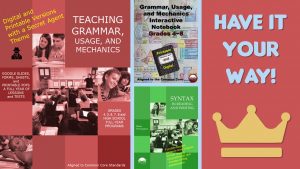FREE Transition Worksheets

Pennington Publishing Grammar Programs
With these FREE transition worksheets, students will learn to identify these syntactic tools in challenging reading text and join ideas, establish relationships, create logical connections between clauses, sentences, and paragraphs in their writing. The reading-grammar-writing connection is well-established in the research:
Syntax study can improve reading comprehension at the sentence level. (Scott & Balthazar 2003)
William Van Cleave’s Syntax Matters, 2017
Inadequate ability to process the syntax of language results in the inability to understand what is heard, as well as what is read. Beyond word knowledge, it is the single most powerful deterrent to listening and reading comprehension.
J.F. Greene, 2011
Fostering young writers’ awareness of the linguistic choices available to them in writing and how those choices differently shape meaning is developing their metalinguistic knowledge of writing.
Myhill, Jones, Lines, Watson, 2013
Language comprehension is one of the most automatic tasks that humans perform. Yet it is also one of the most complex, requiring the simultaneous integration of many different types of information, such as knowledge about letters and their sounds, spelling, grammar, word meanings, and general world knowledge. In addition, general cognitive abilities such as attention monitoring, inferencing, and memory retrieval organize this information into a single meaningful representation.
Van Dyke, 2016
TEACHING ESSAYS BUNDLE
Often students rely on comfortable syntactic structures, such as the subject-verb-object sentence. Additionally, students tend to rely on simple chronological writing transitions, such as first, second, next, etc. These 11 free transition worksheets are organized by purpose: Definition, Example, Explanation or Emphasis, Analysis, Comparison, Contrast, Cause-Effect, Conclusion, Addition, Number or Sequence. Each worksheet includes identification within text (reading comprehension), fill-the-blank syntax practice (grammar), and application (writing). Answers provided. The transition worksheets will improve writing coherency and unity.
To improve reading comprehension and writing sophistication, check out the reading, grammar, and writing resources from Pennington Publishing. Each product description includes a complete preview of each program.

